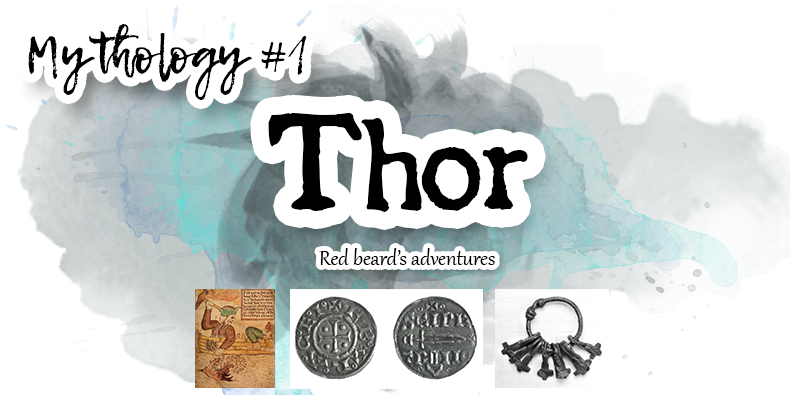Then said Gangleri: «What are the names of the other Æsir, or what is their office, or what deeds of renown have they done?» Hárr answered: «Thor is the foremost of them, he that is called Thor of the Æsir, or Öku-Thor; he is strongest of all the gods and men. He has his realm in the place called Thrúdvangar, and his hall is called Bilskirnir; in that hall are five hundred rooms and forty. That is the greatest house that men know of.
Thor has two he-goats, that are called Tooth-Gnasher and Tooth-Gritter, and a chariot wherein he drives, and the he-goats draw the chariot; therefore is he called Öku-Thor. He has also three things of great price: one is the hammer Mjöllnir, which the Rime-Giants and the Hill-Giants know, when it is raised on high; and that is no wonder, it has bruised many a skull among their fathers or their kinsmen. He has a second costly thing, best of all: the girdle of might; and when he clasps it about him, then the godlike strength within him is increased by half. Yet a third thing he has, in which there is much virtue: his iron gloves; he cannot do without them when he uses his hammer-shaft. But no one is so wise that he can tell all his mighty works; yet I can tell thee so much tidings of him that the hours would be spent before all that I know were told.
Gylfagynning XXI
A multiple god and a magic hammer
In the Eddas, Thor is known as the oldest son of Odin and for his fiery temperament. His mother is Jörd, a giant whose name means “Earth”.
In the Sagas, Thor is also referred to as “red beard”. As mentioned above, his kingdom is the Thrudheim, and his great hall is called Bilskirnir. He is best known as the master of the storm and lightning, but he also has a great role as “patron of humanity” since he is considered close to ordinary humans, those who do not have a particularly high social status. Also, due to his status of “sky god”, he participates in the fertility of the earth. But all this would only be part of his many facets: he defends and promotes the common good, he heals, and he is also often described with incredible strength (especially thanks to its magic belt, Megingjörð, which doubles his strength when worn*).
He has two magical goats, Tanngnjóstr and Tanngrísnir, which he can kill and eat endlessly because as long as their bones remain intact, they come back to life the next day. These two goats pull the cart in which he moves.
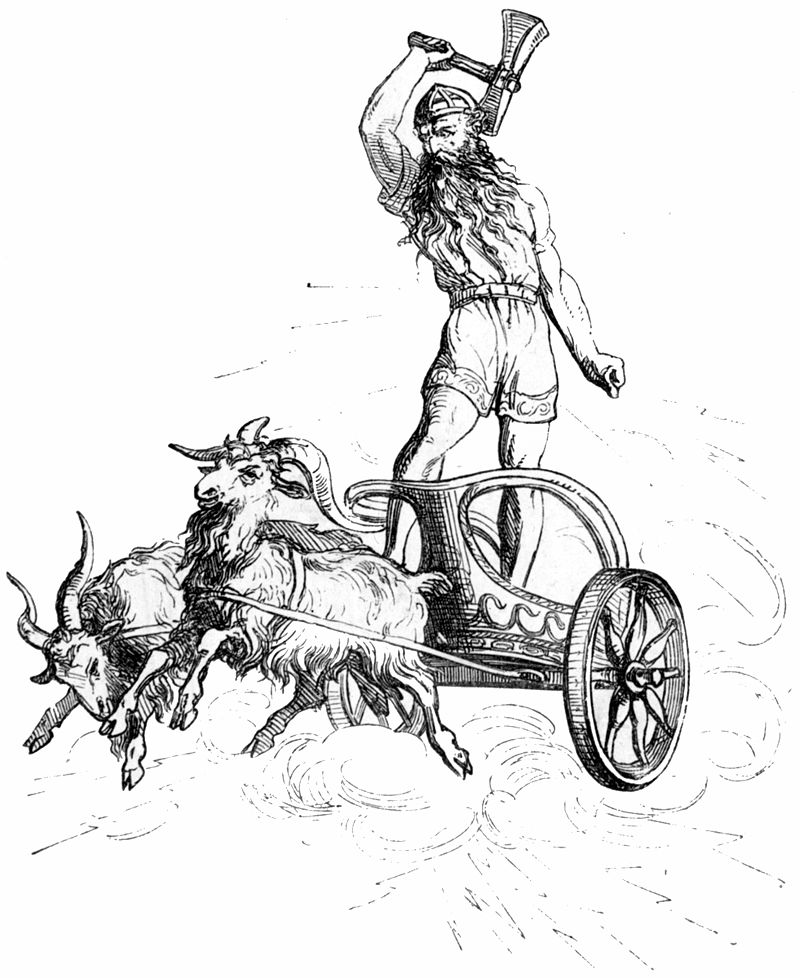
The way Thor acquired his hammer, the famous Mjöllnir (or Mjölnir, or Mjolnir, or Mjolnir, it’s up to you), is told by Snorri in the fifth chapter of the Skáldskaparmál (The Poetic Art). We learn that Loki (the god of mischief, officially, but he also deserves an article) cut the hair of Sif, the goddess with whom Thor had his daughter called Thrud. Thor then gets really angry, and while he wants to kill Loki, he stops him and promises to go find the dwarves so that they can make Sif a golden hair that grows like real hair. Loki therefore went to see the said dwarves, called Ivaldi’s sons, and they made him the golden hair as well as a boat called Skidbladnir and a spear called Gungnir. And then Loki, who can’t help and behave properly for more than five minutes, bets his head to the dwarf Brokk, who just crafted all the stuff, that his brother Eitri won’t be able to produce objects as precious as these. Then Eitri gets to work, getting himself badly annoyed by a fly, and makes a boar out of gold silk, then Draupnir, a gold ring. He then began to make another object, warning his brother that if he stopped the maneuver along the way, everything would be ruined. He was still getting bothered by the same fly during the process, and had to remove from the furnace what was being manufactured: a hammer.
Loki and Brokk then returned to Asgard to offer the objects to the Ases. Loki gives the Gungnir spear to Odin, the hair for Sif to Thor, and the Skidbladnir boat to Freyr. These objects obviously have super powers: the spear never stops while it is being thrown, the hair grows as soon as it is placed on one’s head and the boat gets a favorable wind directly when its sail is hoisted, but can also bend so small that it can slip into a pocket. Then, Brokk presents Eitri’s objects: he gives the Draupnir ring to Odin, indicating that every ninth night, eight rings of the same weight as it would drip from it. He gives the boar to Freyr, and declares that since the silks of the boar are super bright, he would illuminate all the darkness in his path, at night as in the world of darkness, and in addition he would run extra fast through the air and the sea. And then Thor receives the hammer, Brokk indicating that it could hit anything as hard as he wants without getting damaged, that he would never miss the goal against toward which he would throw it and that it would even come back into his hand, and that it could become so small that it would fit in his coat. But, because of the fly incident, the hammer’s handle got a little short.
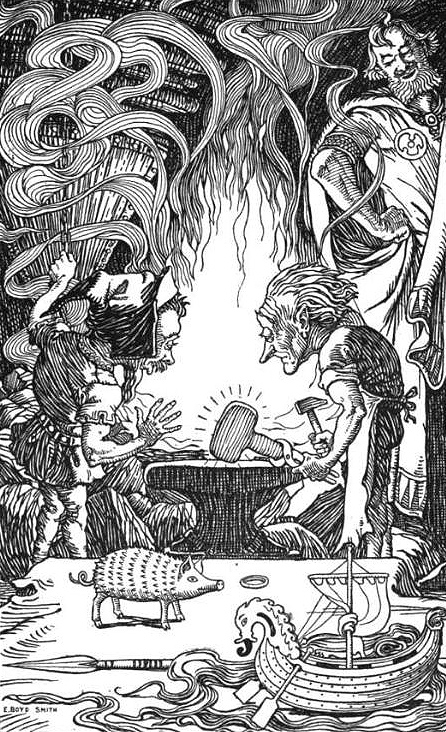
I shall remind you that the last objects are the result of a bet between Loki and Brokk: it is therefore decided that Brokk wins the bet, because the hammer was really the coolest of the manufactured objects and that it was a damn good protection against the frost giants. So Loki offered Brokk to buy his head back, but the dwarf refused. So Loki plays a “catch me then!!!” and runs away super fast thanks to his magic shoes. Brokk then asks Thor to catch him for him, and Thor does it. Brokk then wants to cut Loki’s head, but the latter specifies that he had bet his head and not his neck (smooth), so Brokkk wants to sew Loki’s lips with a strap and tries to pierce them with a knife… Without success. He then tries to pierce them with his brother’s tool used to pierce leather, and it only works temporarily, since Loki tears the strap immediately. Moreover, the strap itself gained a name in this story: Vartari.
Thor dies during the Ragnarök (the twilight of the gods), as he defeats his great enemy the serpent Jörmungandr, with the help of Mjölnir.
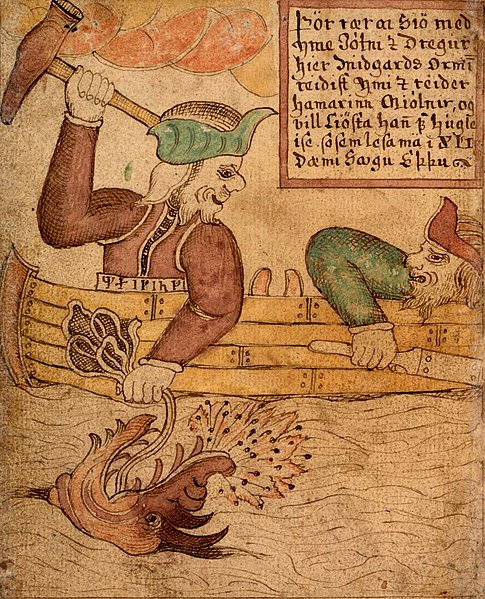
If you like this kind of story, the writings of Norse mythology are full of it. Thor is in many of them and of course I’m not going to write them all down here. I can only advise you, on the other hand, to read the Edda, which includes some of the most important ones and which contributes greatly to the understanding of the joyful mess that is the Norse mythology (plus, if you are a fan of Tolkien’s work, there are lots of things that will make you think “ah, that’s funny”)!
Thor and archaeology
Since we are on an archaeology blog, this is the part that can’t be missed. We will briefly focus on two themes in particular: the traces of the cult of Thor and the amulets discovered in the Viking world.
The cult of Thor during Viking Age
As you probably know (and if you didn’t know, now you will), the Vikings didn’t just stay in Scandinavia. They had a long period of time in England (which saw one of the first Viking raids in 793, at the monastery of Lindisfarne), in Eastern Europe, and also in France. Unfortunately in France, no traces of Thor’s cult have been found to date… But in England and the Eastern European countries, there are many indications that he was quite popular.
For example, in England, there are coins with a Thor’s hammer depicted. They date back to the 920s and have been found mostly in monetary treasures. We can also talk about place names, but this topic is complex and especially most of the time debatable. For example, Thoresway, in Lincolnshire, could come from the Danish “Þórswæ”, meaning “the altar dedicated to Thor”… But could also be the mixture of the name “Þórir” and the old English “weg”, meaning “route of Þórir”.

In Scandinavia, there are obviously many clues about the cult of Thor, whether on engraved stones, or miniature sculptures of the god, or even written testimonies of visitors to the “temple of Uppsala” dedicated to Odin, Thor and Freyr, such as Adam of Bremen (although controversial) who describes a temple with a huge tree nearby, as well as a fountain with human sacrifices.
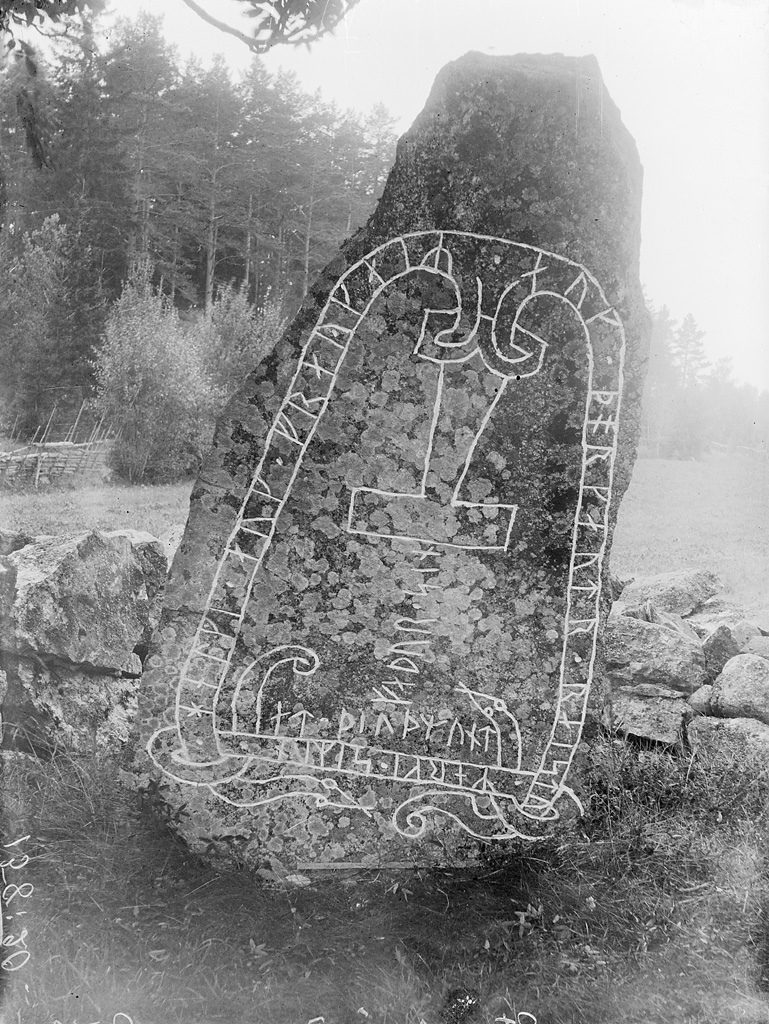
Thor’s hammer rings and pendants
In terms of archaeological material, I will focus here on Thor’s hammer amulets, which are very numerous and visible throughout the Viking world. Indeed, miniature Thor hammers have been found in different forms and materials everywhere, in Scandinavian countries of course, but also in Eastern European countries, in England and even some in France.
These amulets are often seen in the form of pendants, but they can also be found attached to a metal ring, sometimes in several numbers, and most of time found placed on funeral urns. The main differences between these two objects are the size, the choice of material, and the location and context of discovery: while Mjölnir pendants are found all over the Viking world, the rings are found – at the current state of research – exclusively in Scandinavia and the Eastern countries.
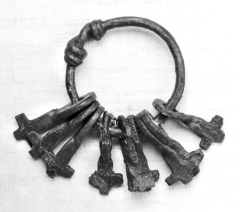
You have certainly seen Thor’s hammer pendants in their current version. Many merchants sell them, both reproductions of “real” Viking Age pendants and original creations freely inspired by older ones. However, for the most part, the material and manufacturing technique are probably quite different.
Mjölnir pendants can be found either in treasures or in graves (less common) and often out of archaeological context (unfortunately). Mjölnir, in Nordic mythology, is an active tool used during social events or in the context of blessing (as Thor uses it for example at the wedding ceremony described in the Thrymskviða, during which he disguises himself as a bride and Loki as a bridesmaid so that Freyja does not marry Thrym the giant… Read the Nordic sagas and poems, I tell you, you won’t regret it). For men and women of the Viking Age, Mjölnir pendants were probably worn as protective amulets, like other types of pendants. It is possible that they were considered “magical”, and maybe used during ceremonies (except funerals, because different amulets were then made especially for the occasion, such as axe-shaped pendants for example). Elsewhere, for Scandinavians living abroad, they were probably also perceived as a strong symbol of identity.
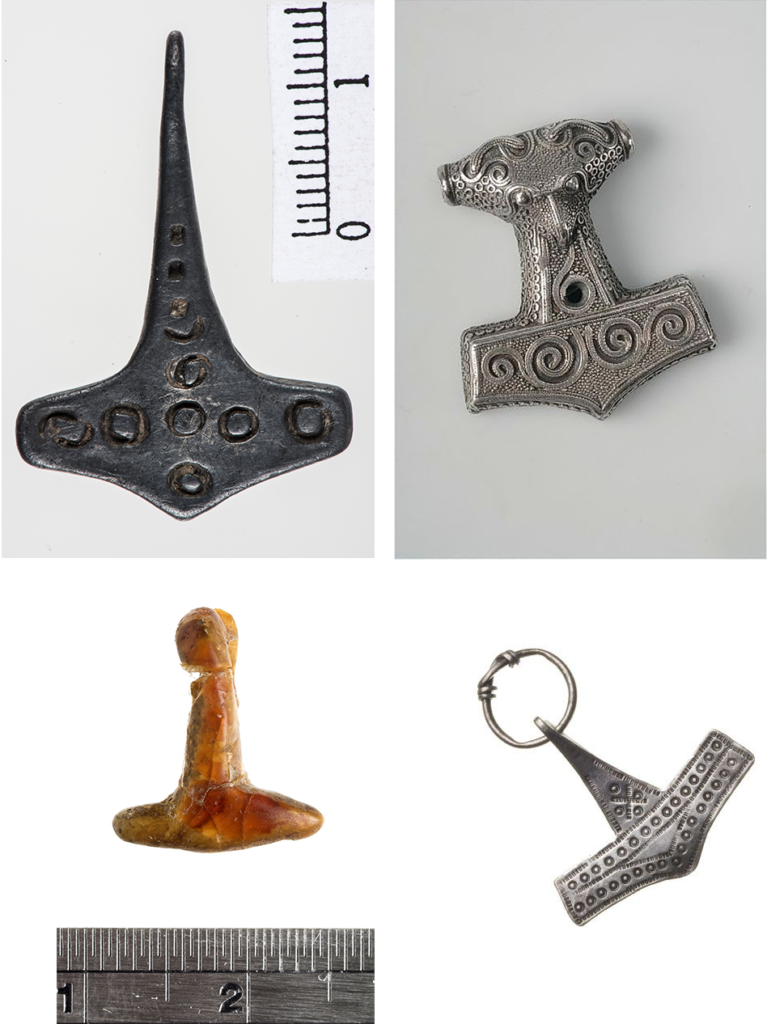
Summary: Thor’s ID card
- Name: Thor
- Nicknames: Asa-Thor, Öku-Thor
- Gender: Male
- Address: Bilskirnir, Trudheim
- Occupation: Protector of humanity, sky divinity, fisherman in his spare time
- Family: Son of Odin and Jörd, brother of Meili, half-brother of Baldr, Höd, Hermod, Vidar, Vali and Bragi, husband of Sif, father of Thrud, Modi and Magni [the latter possibly being the son of the giant Járnsaxa]
- Looks: Tall, rather muscular, bearded, long, red hair
- Notable possessions: The hammer Mjölnir, the belt Megingjörð, the goats Tanngnjóstr and Tanngrísnir, a cart, iron gloves
- Cause of death: poisoned by Jörmungandr during the Ragnarök
- Common cult throughout the Viking world
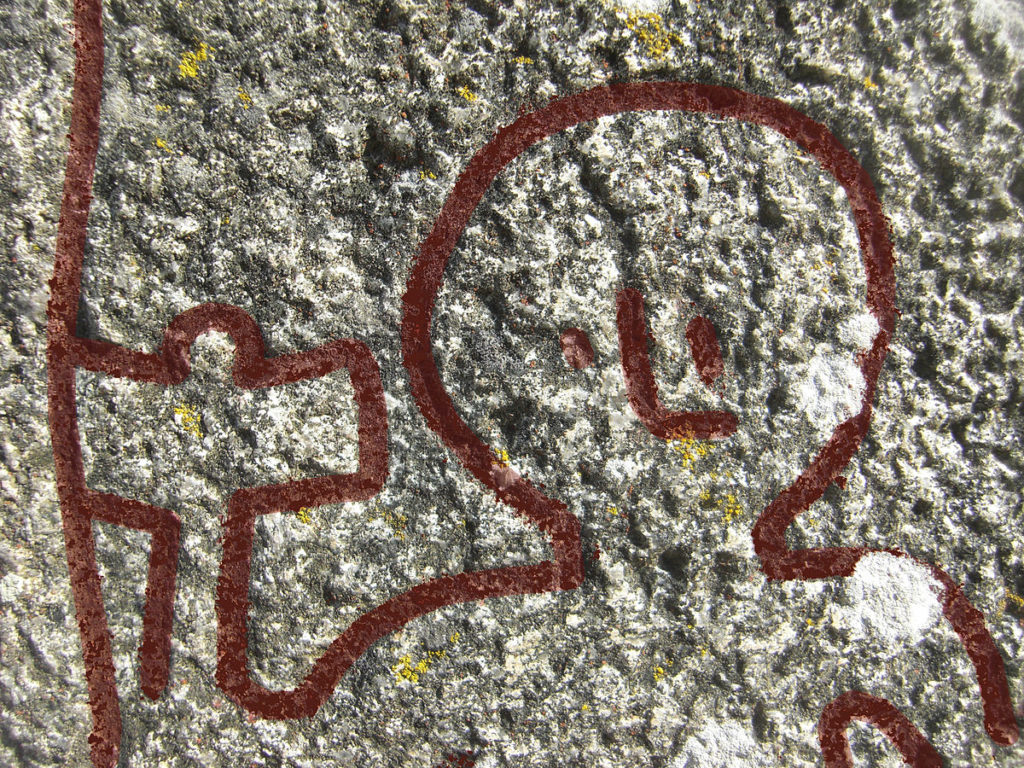
And here is where the article ends! I’m sorry for publishing sooo slowly, I try to do my best to be able to publish one article per month…. Well, it’s been two months. But I’ll make it up to you, even if it means making shorter articles. I hope this one was still worth the wait, and as usual feel free to leave me a comment, share if you liked it, etc!
See you next time!
*In the intro, it says “his strength is increased by half”, but here I say it doubles; this depends of the various sources and translations.
Sources
- Lesley Abrams, “Diaspora and identity in the Viking Age”, Early Medieval Europe 20, 2012, pp. 17-38
- Gunnar Andersson, “With Thor on our side”, Dealing with the dead – archaeological perspectives on Prehistoric Scandinavian burial ritual, 2006
- James Graham-Campbell and Gareth Williams, Silver economy in the Viking Age, Routledge, 2007
- Danièle James-Raoul and Claude Tomasset, Dans l’eau, sous l’eau : le monde aquatique au Moyen-Âge, Culture et civilisations médiévales XXV, 2002
- Bo Jensen, Viking Age amulets in Scandinavia and Northern Europe, Archaeopress, 2010
- Lucie Marie, Thor’s hammer pendants in England, Master thesis in archaeology, Stockholm University, 2017
- Joshua J. Mark, Thor, Ancient History Encyclopedia, 17 December 2018
- Galina L. Novikova, “Iron neck-rings with Thor’s hammers found in Eastern Europe”, Fornvännen 87, 1992, pp. 73-89
- Snorri Sturluson, L’Edda, récits de mythologie nordique, french translation by François-Xavier Dillmann, Gallimard, 2014
For this article, I obviously used a non-exhaustive list of sources, selected from those to which I had access, and I apologize in advance if any important information is missing. It may be edited if necessary. This is NOT a scientific article, it is intended only to popularize and open up to more information – I strongly encourage you to go further in your reading if you are interested in the subject, especially via the proposed sources!

